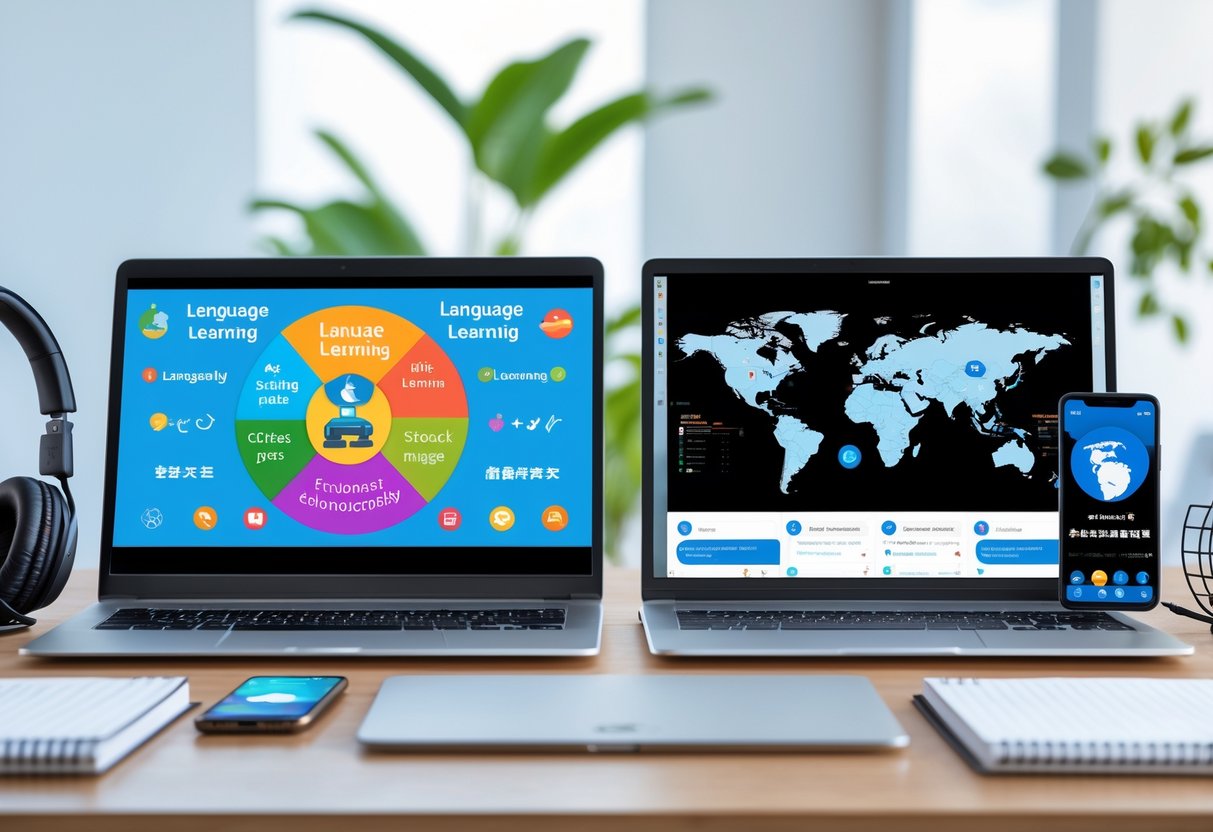Choosing between Duolingo vs Rosetta Stone can be tricky when you want to learn a new language online. Duolingo is known for being fun, fast, and free, while Rosetta Stone focuses on deep immersion and clear lessons.
If you are unsure which one fits your learning style and budget, you are not alone. This quick guide will help you figure out which tool works best for your needs.
Key Takeaways
- Each platform offers a unique way to learn a language.
- Features, lesson style, and cost are main differences.
- Picking the right one depends on how you like to learn.
Key Differences Between Duolingo and Rosetta Stone
Duolingo and Rosetta Stone both help you learn languages but they work in different ways. They use unique teaching methods, different approaches to immersion and translation, and offer distinct speech recognition tools.
Teaching Methods and Approaches
Duolingo uses short, game-like lessons. You earn points, level up, and get rewards as you learn. The app is fast-paced and encourages you to practice a little every day.
In contrast, Rosetta Stone follows a more traditional path. You see pictures, hear words, and match them without using your native language. The focus is on natural learning, similar to how children learn their first language.
Duolingo often teaches vocabulary using translation. Rosetta Stone avoids direct translation and works instead through repeated exposure and association. Your learning experience is more structured and controlled with Rosetta Stone. Duolingo gives you more flexibility and variety.
Immersion vs Translation-Based Learning
Rosetta Stone uses a full immersion method. All instructions, activities, and lessons are in the language you are learning. No English translations are provided. This can help you start thinking in the new language faster.
Duolingo takes a translation-based approach. Most exercises ask you to translate between languages, either to or from your own. You might see a sentence in English and type it in Spanish, for example.
Rosetta Stone’s immersion can feel confusing if you need clear explanations. Duolingo’s method is friendly for beginners who prefer to see direct translations and explanations. If you like learning by figuring things out, you may prefer Rosetta Stone. If you like clarity, Duolingo may feel easier.
Technology and Speech Recognition
Both apps use speech recognition, but the features are not the same. Duolingo lets you speak words and short phrases into your device’s microphone. The app tells you if your pronunciation is close enough, but feedback is basic.
Rosetta Stone uses its own speech recognition system called TruAccent. It analyzes your speech more deeply and helps you improve accuracy. TruAccent tells you which sounds you got right or wrong.
Duolingo’s speech tools work well for practice, but are simpler. Rosetta Stone’s tools are more advanced, especially for fine-tuning accent and pronunciation. If pronunciation is most important to you, Rosetta Stone gives you detailed feedback. If you just want to get started, Duolingo’s system is quicker to use.
Features and User Experience

Rosetta Stone and Duolingo offer different ways to help you learn a language. You will notice differences in their lesson formats, game-like elements, study paths, and extra tools.
Lesson Structure and Progression
Duolingo uses short, interactive lessons. These lessons focus on vocabulary, grammar, reading, speaking, and listening skills. The app’s structure is like a path with many small checkpoints. You unlock new topics as you make progress along the path.
Rosetta Stone organizes lessons around themed units, such as greetings or travel. Each unit is longer and works through only the target language. There are no translations or direct explanations in your native language. Instead, you get all instructions through pictures, audio, and context—an approach called “immersion.”
Duolingo lessons tend to be faster and easier to repeat in small bursts. If you learn best by repetition, Duolingo fits well. Rosetta Stone lessons are longer and often require more focus in each sitting.
Gamification Elements
Duolingo is well-known for its heavy use of gamification. You earn XP points, level up, and maintain “streaks” for completing daily lessons. There are also leaderboards where you compete with other users.
You can collect rewards, such as gems, to unlock bonus lessons or costumes for your Duolingo avatar. Motivational pop-ups and encouraging sounds help keep you involved. If you miss a day, the app reminds you to keep your streak alive.
Rosetta Stone keeps things more traditional. It doesn’t use game-like rewards, streaks, or leaderboards. Progress is mostly tracked by lesson completion. If you are motivated by scores or competition, you may find Duolingo’s system more engaging.
Learning Paths and Motivation
Duolingo lets you personalize your learning by choosing topics such as travel or business. The path is flexible, and you can try Duolingo Stories for extra practice in reading and listening. For those who pay for Duolingo Plus, you unlock extra features like offline lessons and progress tracking.
Rosetta Stone is more linear. You move through the course in a set order, without skipping ahead. This structure is designed to build vocabulary and grammar step by step. It may be better if you prefer a clear, guided path.
Duolingo’s reminders and rewards can keep you motivated longer. Rosetta Stone depends more on your self-discipline and routine.
Supplemental Resources
Duolingo includes podcasts, stories, and a forum where you can discuss questions. Stories add context by using real conversations with audio and quizzes afterward. Its podcasts (like the Duolingo Spanish Podcast) help build listening skills.
Rosetta Stone offers live tutoring sessions as an add-on. Certified tutors help you practice speaking. Some versions also offer phrasebooks and pronunciation guides using voice recognition.
Below is a quick comparison:
| Feature | Duolingo | Rosetta Stone |
|---|---|---|
| Podcasts | Yes (for some languages) | No |
| Stories | Yes | No |
| Live tutoring | No | Yes (with extra cost) |
| User forums | Yes | No |
| Pronunciation tools | Yes (voice AI) | Yes (with speech recognition) |
Both apps give extra tools, but in different ways. Duolingo leans on digital media and community, while Rosetta Stone focuses more on personalized support.
Language Coverage and Accessibility

Duolingo and Rosetta Stone both offer tools for language learning, but there are differences in how many languages you can learn and how you can access the lessons. If you need Spanish, French, or Japanese, both apps have them, but their options and how you use them are not always the same.
Available Languages and Course Options
Duolingo offers more than 40 languages, including Spanish, French, Japanese, Korean, and even fictional languages like Klingon and High Valyrian. The platform supports many popular choices as well as less common ones like Hawaiian and Navajo.
Rosetta Stone has around 25 language courses. It focuses on widely spoken languages such as Spanish, French, Italian, German, and Mandarin Chinese. You will not find fictional languages here, and the selection is more traditional.
Duolingo’s courses often include extra features like stories and podcasts in some languages. However, not all languages get the same amount of content. Rosetta Stone’s courses are more consistent in quality and structure, but some less-studied languages have less content.
Table: Number of Languages
| App | Number of Languages | Includes Fictional Languages |
|---|---|---|
| Duolingo | 40+ | Yes |
| Rosetta Stone | 25+ | No |
Mobile and Desktop Platforms
You can use Duolingo on iOS, Android, and any web browser. The interface is almost the same on both mobile and desktop, making it easy to switch between devices. Features like reminders and progress tracking also work across platforms.
Rosetta Stone is also available on iOS, Android, and web browsers. The desktop experience is important because some features, including pronunciation tools, work best on a larger screen. The mobile app supports most core lessons but sometimes limits advanced features.
Both apps let you sync your progress so you can change devices without losing your place. This helps if you want to practice on your phone during a commute and then switch to your computer at home.
Offline Learning Capabilities
Duolingo allows offline learning, but only if you use the mobile app. Free users can access a limited number of lessons while offline, but Duolingo Plus (the paid version) lets you download more courses.
Rosetta Stone supports full offline access to lessons if you use the mobile app. Once you download a unit, you can use all interactive activities and speech-recognition exercises without internet access.
If you expect to learn where Wi-Fi is limited, this feature is important. Both offer some type of offline access, but Rosetta Stone’s is less restricted for all users, while Duolingo keeps full offline access as a paid feature.
Pricing and Subscription Models

Both Duolingo and Rosetta Stone offer different pricing and access options. You will see clear differences in cost, what you get for free, and what premium upgrades unlock.
Free vs Paid Plans
Duolingo is free at its version with ads and basic features like daily lessons, practice exercises, and leaderboards. You can learn as much as you want without paying, but ads may appear between lessons. Progress tracking and reminders are included for free.
Duolingo Plus is its paid upgrade. It removes ads, adds offline access, enables unlimited mistakes, and gives progress reports. You can try it with a free trial before purchasing. The free and paid plans share the same core content.
Rosetta Stone does not have a true free tier. Instead, it offers a short free trial that gives you access to its lessons for a limited time—typically a few days. After the trial, you must pay to continue using the app and lessons.
| Feature | Duolingo Free | Duolingo Plus | Rosetta Stone Trial | Rosetta Stone Paid |
|---|---|---|---|---|
| Lessons | Yes | Yes | Limited time | Yes |
| Ads | Yes | No | No | No |
| Offline access | No | Yes | No | Yes |
| Unlimited Mistakes | No | Yes | No | Yes |
| Speech Recognition | Yes | Yes | Yes | Yes |
Cost Comparison and Value
Rosetta Stone vs Duolingo
Duolingo Plus costs about $7 to $12 per month, depending on your subscription length. There are discounts for yearly plans. You can also use family sharing to lower the cost per user. All language courses and features are included in the price.
Rosetta Stone has several pricing options. A three-month single language plan is around $36. The yearly plan is about $96 for one language. The “Lifetime” plan gives access to all languages for a one-time fee, usually about $199. Discounts are common during sales.
Duolingo is usually less expensive, especially if you use the free plan. Rosetta Stone has a bigger upfront cost but may be valuable if you will use it long-term or want access to all languages. Both offer some trial period to help you decide before paying.
Access to Premium Features
Duolingo Plus members get several upgrades:
- No ads during lessons
- Download lessons for use offline
- Unlimited “hearts” so you can make mistakes without waiting
- Progress tracking and quizzes
These features make it easier for you to practice without interruptions or time limits. Free users do not get these extras but can still learn every language.
Rosetta Stone’s paid users get:
- Full access to all lessons for their chosen language
- Speech recognition with TruAccent™ technology
- Download lessons for offline use (with the app)
- Access to live tutoring sessions (in higher-tier plans)
- Phrasebooks and stories for deeper practice
You cannot access most of these premium features without a paid plan. Everything is unlocked at once so you can go at your own pace. The live sessions with tutors are unique to Rosetta Stone and require the highest plan.
Frequently Asked Questions
Costs, community opinions, features for children, and different learning levels matter when picking a language app. Understanding these differences can help you decide which option fits your needs best.
Which language learning app offers the best value for its cost?
Duolingo has a free version with ads and a paid version called Super Duolingo. The paid version adds more advanced features and removes ads. Rosetta Stone does not have a free version but offers a money-back guarantee and a one-time payment option.
Duolingo is often considered more affordable if you want to learn without spending money. Rosetta Stone’s pricing can be better for people who want a more traditional course with set lessons.
How do user experiences compare for language learning apps on online forums?
Many users say Duolingo is fun and easy to use because of its game-like style. People like earning points and keeping streaks. Some forum posts mention that Duolingo is good for reviewing or learning the basics, but not enough for fluency.
On forums, Rosetta Stone reviews often praise the app’s focus on immersion. Users say that lessons are clear and well-structured. Some users feel Rosetta Stone is better for people who want to practice speaking more, while Duolingo offers more languages to try.
What are the benefits of using language learning apps for children?
Language apps let children practice at their own pace and in small steps. Most apps use fun designs, cartoons, and positive feedback to keep kids interested. Parents can track their child’s progress or set daily goals.
Some apps, like Duolingo, have a special version called Duolingo Kids. It is made just for children and has simple language and bright colors. Rosetta Stone has lessons suited for younger language learners and uses lots of pictures.
How do language learning app features differ for beginner versus advanced learners?
Duolingo’s lessons for beginners use short, simple sentences, and lots of pictures. As you progress, exercises get harder, but many users say it is better for beginner and intermediate practice.
Rosetta Stone teaches using only the target language, even for beginners. Advanced learners on Rosetta Stone can do pronunciation practice and work on full conversations. Both apps offer review tools, but options for advanced content may be limited in comparison to formal classes or real conversations.

